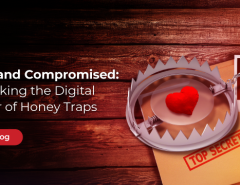February 14th, Valentine’s Day, maybe the day of love but there’s no love lost between cybercriminals and their target. In recent years, these criminals are only getting smarter in their ways and ensuring that they time their attacks at times of popular celebration when most users will be at risk. And Valentine’s Day provides a great opportunity.
Valentine’s Day offers a goldmine of information for hackers and other criminals as many users turn to the Internet to buy gifts, find deals and do other kinds of e-commerce activity in the hope of giving their beloved the best Valentine’s Day gift. While that is certainly a noble thought, it is no excuse to loosen one’s guard because you can be sure that cybercriminals won’t. As you celebrate this Valentine’s Day, here are a few tactics to be careful about:
Fraudulent Emails
This tactic relies on human infallibility and can be even more effective on such special occasions. Users may receive an email or an e-greeting from a suspicious source. To view the card, they will be asked to click on a particular link. Clicking on that link can download malware which can have devastating effects on the computer and the network. The computer may get compromised and become part of a Botnet. The only solution to this is to be careful and not get carried away: the mysterious Valentine at the other end of the mail thread is probably a cyber criminal.
Malicious apps that take advantage of the celebrations
Cybercriminals will often create malicious apps that will be close or almost identical to popular dating apps like Tinder. Users can often get fooled by these and download these to their systems, mistaking them for the real one. Once downloaded, these malicious apps can cause havoc by accessing and transferring the personal information of users. A strong mobile antivirus is a must, but organizations must also educate employees about the dangers lurking on App Stories and how to identify fakes.
Special offers that turn out to be a scam
This tactic tries to take advantage of internet shopping. Users may come across banners or emails offering great Valentine’s Day deals which are too hard to believe. They may offer some unbelievable prices or some special items. In a hurry to buy gifts, users may often get attracted to these offers and browse these websites which is a very risky move. Just accessing these websites could open the network to malicious Trojans or other types of malicious software. If users input their key details like financial information or personal address, this could even lead to identity theft.
Hacking dating apps
It’s pretty obvious. Usage of dating apps peak during Valentine’s month and it’s not hard to understand why as most users seek to find a soulmate at this time of love. But cybercriminals are in the game as well and dating apps provide a great opportunity. Apart from the usually fraudulent ones created just to garner information for unknowing targets, a study in 2016 discovered that some of the most popular dating apps are severely lacking in security and can be easily hacked. Users should be very careful about the data they put in dating apps when creating profiles on these platforms and remember that they could always be misused.
While candles and teddy bears have been trademark Valentine’s Day presents, a great gift this year would be to bolster your personal as well as enterprise security by implementing a robust security solution.




